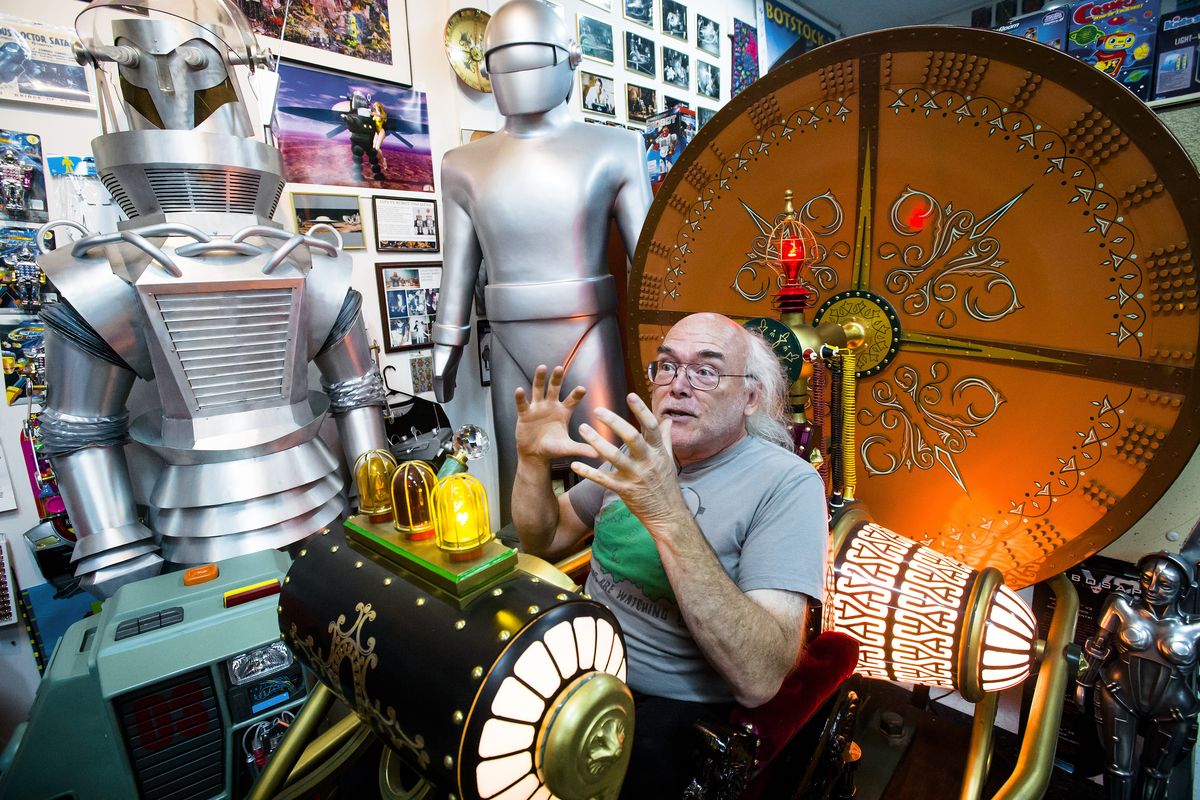Robo crop
One-of-a-kind contraptions, sci-fi collectibles and all things robot fill private museum

I drove a half-hour northeast from Spokane the other day, headed for one of the area’s best-kept secrets.
Another 3 miles of country road led me to a red metal building that has nothing at all to do with the surrounding farms, tractors or livestock.
The Robot Hut is, in fact, one of the largest privately owned shrines to pop culture robots. John Rigg, the museum’s owner, curator and mad scientist, estimates his collection at 4,000 pieces – and growing.
The exhibits range from highly prized Japanese tin toys to full-sized, hand-built movie robots like those lovable scene-stealers from “Star Wars,” the homicidal Terminator and Robby the Robot from “Forbidden Planet,” the 1956 sci-fi classic.
“For your convenience, I am modified to respond to the name Robby,” a Robby tells me when I wander by.
Man, I love this place. It’s been 13 years since my first visit to this barn of enchantment. Back then, the collection was maybe half what it is now.
“You used to be able to skateboard or ride a bike through the aisles,” said Rigg with an amused chuckle. “Now I’m kind of running out of room.”
Some exhibits are familiar. The Robbys, for example. And Gort, the robot that held the world in check in “The Day the Earth Stood Still,” another flick from my boyhood.
So many attractions are new.
The robot-themed pinball machines, say. Those stubby robots from “Silent Running,” Huey, Dewey and Louie.
The Machine Man Band is a marvel unto itself.
It’s more a duo, really. Two tall robots (about 5 feet each) contain percussion and instrumentation to rival the Riverfront Park Carrousel.
Rigg, a fabulous engineer and fine musician, cut all the sound pipes and created the computerized arrangements to songs like Billy Joel’s “Uptown Girl,” which the Machine Man Band performed at ear-splitting jubilance.
In the museum’s earlier days, Rigg let the public schedule private tours. Due to time constraints he now limits his tours to journalists, authors and members of the robot press.
This Rigg is something else. It’s one thing to amass a collection of something. Anyone with the right amount of passion and a fat savings account can do that.
But Rigg has Big League abilities when it comes to engineering, design and fabrication.
The full-scale Hollywood replicas he’s created aren’t just good, they’re flawless masterpieces, the result of natural talents and decades of professional effort.
“I was wiring 110-volt circuits when I was 6 years old,” Rigg said of his early interests.
Receiving a toy robot as a Christmas present one year, Rigg took it apart because he was “enthralled by the mechanics of it. I wondered, ‘How are they doing that?’ ”
Growing older, Rigg turned his attention to normal guy stuff like girls and rock music. He graduated from Shadle Park High School in 1972. His electronics and engineering genius landed him a job as head engineer for Seattle’s Audio Environment Incorporated.
Rigg designed and built complex circuitry, sound studios and equipment used in CD duplication and satellite receivers. He retired after 18 years. Rigg and his wife, Pam, moved to the farmland near Elk because the real estate was reasonable and there was enough room to display the robots.
Oh, yeah. The robots.
Rigg began his collection in 1980 as a lark. He decided to buy the six favorite toy robots that he had as a kid.
“It took me two or three years to find the six,” he added, “but in the process I had collected 600 others.”
The collection, like I said, was just part of it. Rigg used his skills to create exact replicas of iconic robots. In that regard, no robot was more important to Rigg than B-9, the snarky robot in TV’s “Lost in Space.”
Rigg had been mesmerized by the series as a boy, but not because of the robot. Rigg identified more with the brilliant character played by the show’s young star.
“I was Will Robinson,” said Rigg. “I could build anything – that’s me. I was that kid.”
It was only fitting for Rigg to let B-9 come to life in a prominent part of his Robot Hut.
“I am not programmed for baby sitting,” the thing wisecracked.
The B-9 stands near a copy of the “Time Machine” that actor Rod Taylor made famous in the 1960 movie. Rigg made another time machine replica that was used not too long ago in a “Big Bang Theory” episode.
Rigg told me once that there was “no point in doing something like this unless you do it right.”
To achieve that goal the builder will go to extraordinary lengths. Rigg has been known to track down a director. Or analyze a movie frame by frame in search of details.
The result of such care is obvious. With its bright lights, checkerboard floor and professional signs, the Robot Hut is a marvel right down to the smoke-blowing silver robot sculpture attached to the outside of the building.
“I never had a goal to have the most of everything,” said Rigg on his love of robots. This is about “the mechanics, the electronics and the art of it all.”